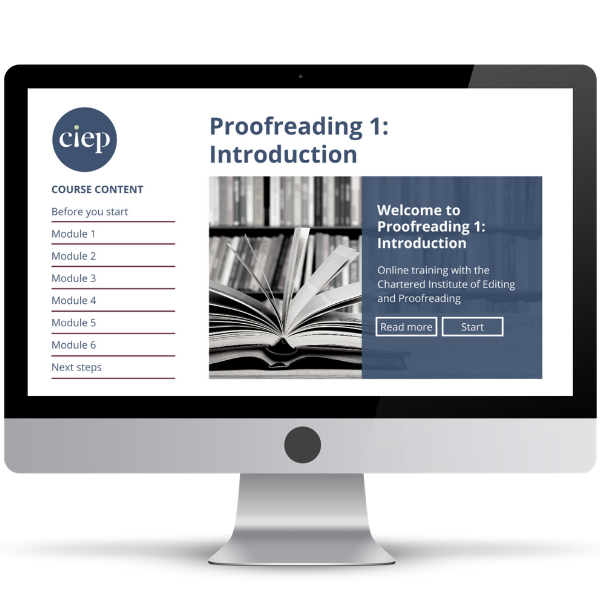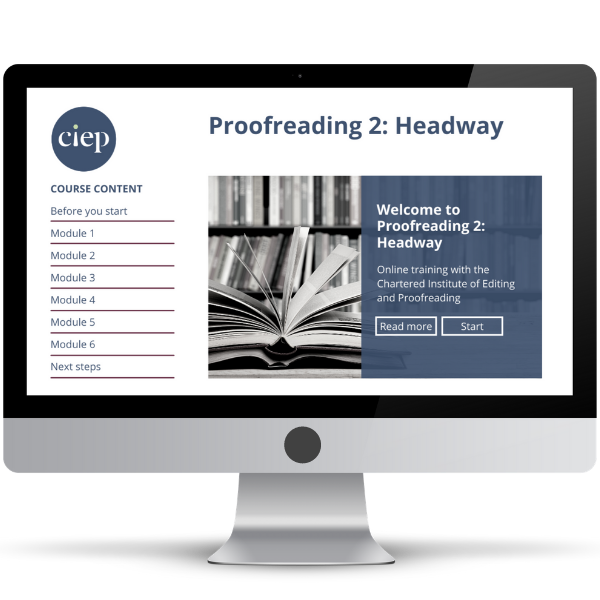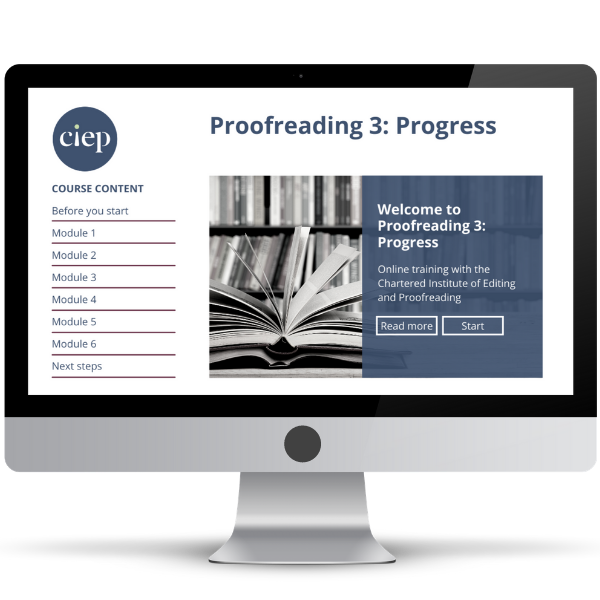What is proofreading?
Whether it’s a manuscript for a novel, a webpage, an academic paper, or a piece of sheet music, any document or piece of text or content can benefit from proofreading to ensure it’s free from errors, that it makes sense, that it isn’t misleading and it is presented properly. Errors in text can damage the credibility of the author, or the reputation of an organisation, but can also have a more serious impact – think, for example, about a recipe with incorrect measurements, or medical instructions or information that haven’t been proofread!
If you want to find out what professional proofreading involves (and what it doesn’t), how you can learn to become a proofreader or what you can expect from a proofreader who’s working on your project, keep reading to find the answers to all of your questions.
Isn’t proofreading just fixing spelling mistakes?
Yes and no. Proofreaders do, of course, correct spelling mistakes that haven’t been picked up earlier in the writing and editing processes. But they also check for consistency across the text as a whole and adherence to style guides – a document that sets out the preferences of an organisation or a client when it comes to various choices for their published text. For example: is the text to be UK English or US English? Are numbers written as words or figures? Are dates written as 29 June, June 29 or 29th of June?
So, as well as looking out for typos, a professional proofreader will find and correct:
- inconsistencies in spelling across a document or text (meter/metre)
- inconsistencies in names, capitalisation and hyphenation (log in/log-in)
- errors in, or missing, punctuation – especially where they might create ambiguity or change the meaning of the text (Let’s eat, Grandma. / Let’s eat Grandma.)
- irregular spacing and bad line breaks (different sized gaps between headings and paragraphs throughout a document, or a word being broken in an odd place at the end of a line, and a hyphen used to link the two parts of the word, which can interrupt the reading flow - eg ree-ducate vs re-educate)
- incorrect headers, footers and foot- or endnotes
- incorrect page numbers – either on the page itself or if the page number doesn’t match a table of contents
- incorrect figures in tables, where columns don’t add up correctly
- incorrect captions under images
- incorrect text in diagrams
- incorrect cross/page references
- missing or repeated text
- wrong phone numbers and email addresses.
Do remember, though, that proofreaders are human beings, and rogue spaces and double full stops might sometimes slip through. No proofread is ever 100% perfect.
What does a proofreader not do?
Unless briefed to do so, a proofreader won’t be altering writing style, rewording sentences, rewriting headings or moving paragraphs around. Fact-checking is also not part of a proofreader’s remit; though they will check with the author or whoever originally produced the text if something doesn’t sound right.
Can’t I just use AI to proofread my document?
Many people are now using AI to check their writing for them. However, AI programs search the internet for information and, as we know, not everything we read online is factually correct! Many AI programs also do not have a good grasp of grammar or the nuances of language. AI may be a useful tool for other types of tasks, but it won’t pick up the errors that a proofreader is looking for – particularly those based around consistency or words which are spelled correctly but are incorrect in the context of the sentence or the overall text. Think of words like affect and effect, or principle and principal.
When does my document or text need proofreading?
Whether something is being printed through a publisher, or being self-published in print or online, proofreading happens after a document has been designed. In the case of a book, the text has usually been through several rounds of editing before it reaches a proofreader. That means that the sentence structure should be sound, the text should be factually correct, and many errors will have already been put right. A copyeditor is usually the last person to have read the text before the proofreader, and they may also often have compiled a style sheet for reference. You can find out more about Copyediting on our What is Copyediting? page.
Proofreaders work on many other kinds of material, too, which may not have been through a copyediting process: marketing emails, sales leaflets, posters, journals, adverts, signage in shops, slides for company presentations, staff newsletters and magazines. Essentially, anything that will be read by someone!
I’m not a publisher. How should I supply my text to a proofreader?
If you’ve written something in Word, proofreaders can use the Track Changes function, which shows very clearly what changes they have made. If you have a PDF, they might use a set of editing tools or stamps within the software. They might even make changes on a paper printout with a red pen. How a proofreader works is a decision between them and their client.
How much will it cost to hire a proofreader?
How much it costs to proofread a document is largely related to how long it takes. You’ll need to agree with a proofreader whether they’ll charge an hourly rate, or a set fee. If you agree on a set fee, they’ll probably want to see a sample of your text.
All proofreaders will charge differently, but to give you an idea, the CIEP provides suggested minimum rates [link] for various types of editorial work, including proofreading.
For a straightforward piece of text, a good rule of thumb for a professional proofreader is between 2,000 and 3,000 words an hour. However, complex text might take longer than that. It’s always best to discuss timescales and expectations with your proofreader. If you have a limited budget, be upfront about this and agree on what’s ‘good enough’ in terms of your text.
I’ve heard the term ‘proof-editing’ – what’s that?
Some publishers – and indeed some proofreaders and editors – now combine copyediting and proofreading stages into one. This is often referred to as proof-editing. It means that the proofreader is not working on the final draft. Proof-editing is heavier than a proofread. It can involve all the things a proofreader looks for, as well as looking for factual errors and sentence flow, for example.
How do I train to be a proofreader?
To be a proofreader, you’ll need to develop an eye for detail and be happy to work independently and methodically. The CIEP offers a suite of proofreading training courses, which will give you the skills and knowledge you need. And by becoming a member [link] of the CIEP, you’ll have access to a whole community of like-minded individuals. Our proofreading courses are designed to introduce you to, and later help you refine, some of the key skills and knowledge required of a professional proofreader:
How do I find work as a proofreader?
Once you’ve built your skills and knowledge, then you’re ready to look for work. A great starting point would be to join the CIEP, and tell as many people as possible what you do; you never know who might need your services. Find local networking groups in your area, start a blog, or use social media platforms like LinkedIn to advertise or look for work; if you have specialised knowledge (maths or science, for example) then make sure you highlight that on your profile. You could even approach publishers and proofreading agencies directly. Once you have enough hours of proofreading experience you can apply to upgrade your CIEP membership and advertise in the Directory of Editorial Services. As a CIEP member, you can also find helpful information on promoting your services as a proofreader through our Knowledge hub, and particularly in our Marketing Yourself guide, freely available to members.
Common proofreading terms and phrases
first pass: the first time a proofreader reads something
folio: a page number
font: a set of characters (letters, numbers, symbols) of the same design; for example, Helvetica, Arial, Verdana
formatting issue: a problem with the layout of a document; for example, incorrect line space or font size
markup: adding comments to a document to show where changes should be made
proof: a version of a document that’s being reviewed for errors; there can often be several ‘rounds’ of proof before a ‘final’ proof (which is ready to be published)
proofreading symbols/stamps: a set of standard marks used by proofreaders to show a typesetter what changes need making
typesetting: the process of arranging text and images on a page
typo: a spelling, grammar or punctuation mistake in a document
Upholding proofreading standards
The CIEP is committed to upholding and promoting high editorial standards, which is why all our members formally agree to abide by our Professional Practice Code.
We also have a formal procedure for complaints and appeals on the rare occasion we receive them.



